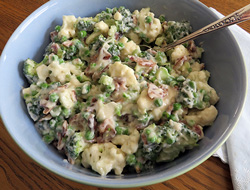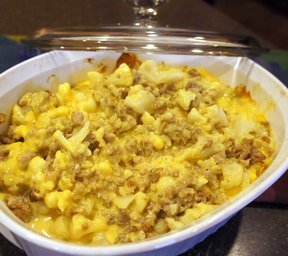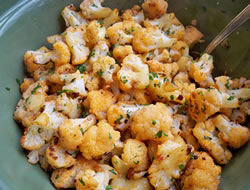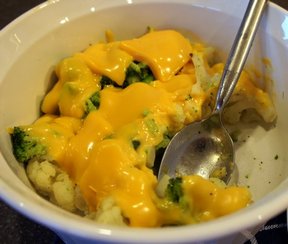|
Cauliflower Preparation | Cauliflower Cooking | Tips
| Cauliflower |
|
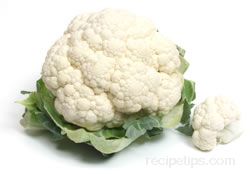
A vegetable that consists of undeveloped white florets attached to a single stem that form a compact, cabbage-like head, called a curd. The curd is generally 6 to 7 inches in diameter. The white head is surrounded by long green leaves that are attached to the stem. These leaves protect the cauliflower from the sunlight, preventing chlorophyll from developing in the cauliflower. Because the head is protected by the leaves, the head stays white. The older varieties of cauliflower had to have the leaves tied up around the curd to protect it but now varieties have been developed where the leaves grow up and around the curd to protect it without tying. Cauliflower is closely related to broccoli but has a denser, more compact head, and it is most often white. It has a creamy, sweet, slightly nutty flavor and even though the florets are the most common part of the cauliflower that is eaten, the stem and leaves are also edible. |
| Uses:
The leaf, stalk and florets can be eaten raw or cooked. Raw, it is eaten on its own accompanied by a dip or cut up and added to salads. When cooked, it can be eaten as a side dish, alone or topped with a sauce, such as au gratin, hollandaise, or Mornay. It is also often added to other dishes, such as stir fries, pasta, quiches, omelets, soups, and stews. Cauliflower can be interchanged for broccoli in most recipes. |
|
At Their Best:
Cauliflower is available year-round. Peak seasons are generally in the spring and fall, depending on the climate in that region. |
|
How to Buy:
When selecting, look for thick, compact, heads of creamy white florets. The head should be heavy for its size and the leaves surrounding it should be bright green and not be showing signs of wilting. Avoid cauliflower that is blemished or whose florets have started to turn brown, which is a sign that the head is getting old. Check the bottom of the head, if it is soft, it is no longer fresh. If the the florets have started to flower they are overripe. Keep in mind that the size of the cauliflower head is no sign of quality. |
|
Storage:
Cauliflower should be left unwashed when storing. Store in the refrigerator, with stem side down, in an open plastic bag or use a perforated plastic bag. This will avoid excess moisture, which causes the cauliflower to deteriorate faster. Store for 5 to 7 days. If cauliflower is purchased as precut florets it will lose its freshness much faster. Store precut florets for up to 2 days. Cooked cauliflower should only be stored for 2 or 3 days in the refrigerator. Cauliflower can be blanched and then frozen and kept in the freezer for up to a year. |
| Varieties: |
|
Cauliflower

|
Most generally referred to as broccoli. This is the most popular and most commonly found broccoli. It consists of dark green clusters of buds, known as florets, which grow on branching arms that connect to a thick leafy stalk. It is also referred to as Calabrese. |
|
Purple Cauliflower
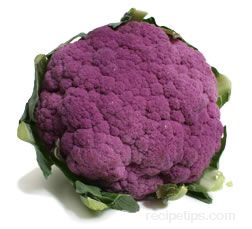 |
This variety of cauliflower has a purple colored curd rather than white as on regular cauliflower. It cooks faster than white cauliflower and has a little milder taste. When cooked, its color changes from purple to green. Purple cauliflower can be substituted for white in most recipes. |
|
Orange Cauliflower
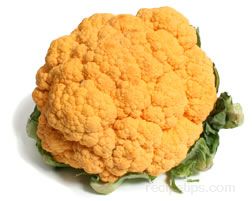
|
An orange colored cauliflower that is a new variety that became available in some supermarkets and farmers' markets in the fall of 2003. It is very similar to regular white cauliflower in taste and appearance except it is bright orange in color. The first variety of orange cauliflower, which was smaller and not as flavorful, was discovered in Canada in 1970 but it took decades of crossbreeding to finally develop the variety that is now available. Because of its high content of beta-carotene, orange cauliflower's vitamin A content is approximately 25 times higher than white cauliflower. Its color and nutritional value are two characteristics that will make this a poplular vegetable choice. |
|
Broccoflower®
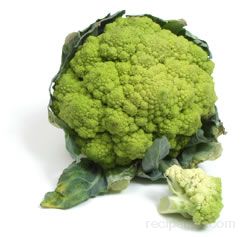
|
A vegetable that is a cross between broccoli and cauliflower. Its appearance is the same as cauliflower except it is light, bright green in color. It has a slightly sweeter taste than regular cauliflower when eaten raw and when cooked, its taste is similar to broccoli. It can be prepared, cooked, and served in the same way you would regular cauliflower.
|
Cauliflower Preparation
Cauliflower should not be washed until it is going to be cut up and used. After the cauliflower has been cut up as shown below, soak it in salt water or vinegar water to help force any insects out that are lodged within the florets.
| Remove the outer leaves from the cauliflower head. |
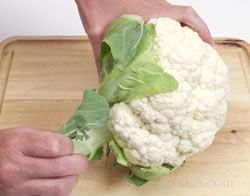 |
| Remove the stalk from the head by cutting around it with a sharp knife. When the stalk is removed, the core with the florets attached will be remaining. |
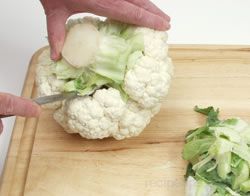 |
| Begin to remove the florets by cutting each cluster from the core, leaving a little of the stem with each cluster. |
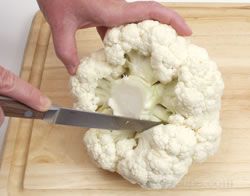 |
| If florets are larger than desired, they can be cut down further by cutting each cluster into smaller uniform size pieces. Finish cutting the remainder of the head in the same manner. |
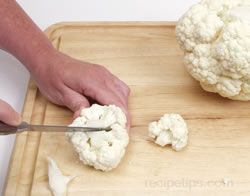 |
Cauliflower Cooking
Cauliflower can be cooked using several methods. Some common methods are steaming, boiling, sautéing, stir frying, and microwaving. Cauliflower should be cooked until they are tender-crisp. If it is cooked too long, the florets will fall apart and become mushy.
Steaming:
|
Add enough water to the pot so that it is below the bottom of the steamer basket when it is placed in the pot. Bring the water to a full boil using a high heat. |
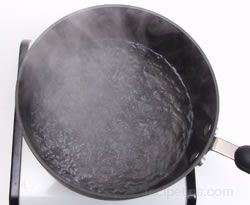 |
| Place cauliflower pieces in the steamer basket. |
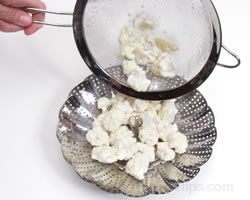 |
| Place the basket in the pot over the boiling water, making sure no water is coming up through the holes in the steamer. Cover and cook for 5 to 10 minutes. Cooking time will depend on the size of the florets. If steaming a whole head, cook for 15 to 20 minutes. |
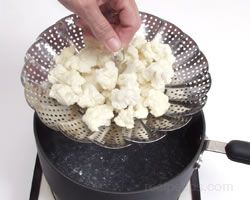 |
|
Check for doneness throughout cooking time by piercing with a fork or the tip of a knife. Cook only until pieces are tender-crisp.
Remove from steamer and prepare cauliflower for serving. |
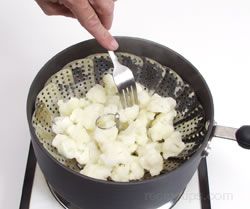 |
Boiling:
|
To speed up cooking time, make an "X" in the core of the cauliflower approximately 1/2 inch deep. |
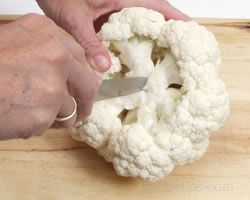 |
|
Add 3 quarts of salted water to a saucepan and bring water to a boil.
Add whole head, core side down, or floret pieces to the boiling water. |
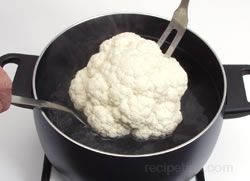 |
| Boil gently, covered or uncovered. Cook whole head for 20 to 25 minutes and floret pieces for 5 to 10 minutes. |
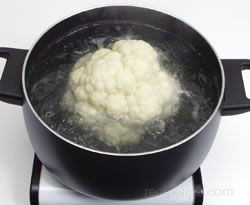 |
|
Check for doneness throughout cooking time by piercing with a fork or the tip of a knife. Cook only until pieces are tender-crisp. |
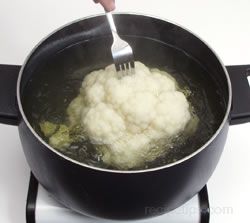 |
| When cauliflower is done, a whole head should be placed on a plate and allowed to sit for a few minutes for the water to drain before preparing to serve. Florets can be drained by placing in a strainer. |
 |
Microwave:
- Place cauliflower florets in a microwave safe dish large enough so the florets are in one heaping layer. If cooking the head whole, wrap it in plastic wrap and place in a microwave safe dish.
- Sprinkle three tablespoons of water over the florets, cover and microwave on high for 4 to 5 minutes. Let stand for 1 or 2 minutes.
- When cooking whole head of cauliflower, microwave on high for 3 to 4 minutes, turn head over and continue to cook for 3 to 4 more minutes. Let stand for 2 to 3 minutes.
- Check for doneness throughout cooking time and cook only until pieces are tender-crisp.
- Drain excess moisture and prepare to serve.
Deep-Fried:
- Cut cauliflower into small to medium size pieces and steam until they are just beginning to get tender. Rinse with cold water and pat dry.
- Heat oil to 375°F.
- Using a batter mix, coat the cauliflower and then carefully place it in the hot oil. Fry until the batter turns golden brown.
- Remove with a slotted spoon or if using a basket, lift out with the basket and let oil drain.
- Place cauliflower on a plate or cookie sheet lined with paper towels so oil can drain off.
- Serve with favorite dips.
When sautéing or stir-frying, it is a good idea to parboil the cauliflower first so it is partially cooked ahead of time. This will allow the cauliflower to be cooked to the proper doneness when sautéed or stir-fried with other ingredients that are faster cooking.
Parboil / Blanch
The same method is used when parboiling or blanching vegetables. The difference between them is the length of boiling time. When blanching, the vegetables are boiled for a very short time, generally ranging from 1 to 3 minutes depending on the vegetable. When parboiling, the vegetables are cooked until they are about half done. Parboiling time is generally 1/2 or less of the normally cooking time.
|
Adding milk to the water will help the cauliflower keep its white color and will sweeten the flavor of the cauliflower. |
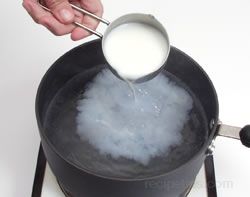 |
|
Bring water to a boil and add the cauliflower pieces. Allow the water to return to a boil and gently boil for 3 to 5 minutes. |
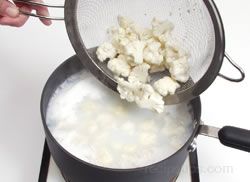 |
|
When parboiled to desired doneness, remove the cauliflower from the boiling water with a slotted spoon and place in ice water to stop the cooking action.
After parboiling, the cauliflower is ready to be sautéed, added to a stir-fry or cooked with other vegetables or ingredients. |
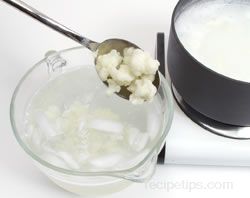 |
Cauliflower contains chemicals that give off an unpleasant odor when it is cooked. The longer it is cooked the stronger the smell becomes. Cooking the cauliflower quickly and only to a tender-crisp state will help minimize the odor and will also minimize the nutrient lose that occurs from overcooking.
Tips
- Do not overcook cauliflower. Overcooking will cause it to break apart, lose its color, diminish its taste, and will cause the lose of many nutrients.
- When blanching or cooking cauliflower, keep it white by adding either 1 or 2 tablespoons of lemon juice, 1 tablespoon of vinegar, or 1 cup of milk. The milk will also give the cauliflower a sweeter flavor.
- For a flavorful side dish, serve cauliflower with a cheese sauce.
- When cooking a whole head of cauliflower, after trimming away the leaves and some of the core, make a "X' that is approximately 1/2 inch deep through the bottom of the core to speed up cooking time.
- Throwing a few chunks of bread into the water when cooking cauliflower will help remove the smell.
- One pound of cauliflower equals 1 1/2 cups cut up. One medium size head equals 1 3/4 to 2 1/4 lbs. or 3 cups chopped. One 10 oz. package for frozen cauliflower equals 2 cups cut up.
- Do not cook cauliflower in an aluminum or iron pot because the chemicals in cauliflower react with the metals in the pots and this causes the cauliflower to become discolored.
|






























